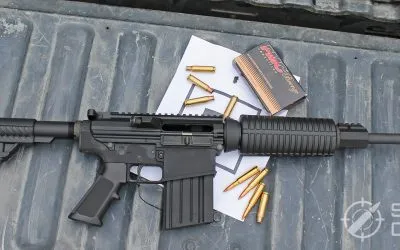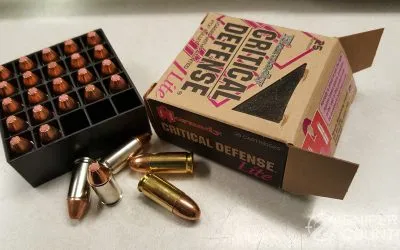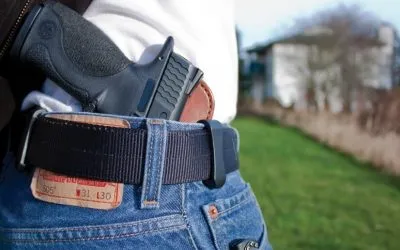Summary
The Ruger Wrangler is an excellent .22 revolver for beginners and experienced shooters alike. Whether for plinking or self-protection, it's an effective, easy to use revolver that is backed by the customer service of Ruger should anything go wrong. The price point (and chambering) makes it one of the more affordable guns for sure.
- It's affordable - at $250 the Ruger Wrangler offers an well made revolver at a genuinely affordable price.
- It's backed by some of the best customer service in the industry - if you've got a problem with it, Ruger, in my experience, will try to make it right.
- .22 ammunition is more affordable - it sets you back a lot less than, say, .357 Blackhawk
- It's easy to load and handle - straightforward for people who want to learn how to shoot or just want a comfortable gun for self-protection.
- Only 6 shots - Ruger could have done more with the space available in the chamber.
- Not the most accurate sights in the world but it's not bad (check out my targets below).
Wrangler n.
A person in charge of horses or other livestock on a ranch.
Oxford Dictionary

So says the definition of the term according to the Oxford dictionary. Bear in mind that a wrangler is different than a cowboy…the cowboy works with cattle, while the wrangler works with horses or other livestock.
What does this have to do with Ruger’s newest .22 LR revolver?
When you look at it, you might see a fairly faithful rimfire copy of the vaunted 1873 Single Action Army. This was the handgun that 'helped win the west', to use that old slogan. Many cowboys and wranglers would have one strapped to their hip if they could afford it. The gun was a tool, much like their rope or saddle. It helped them in their day-to-day life.
This modern Wrangler revolver can perform the same function, especially if you live out in the boonies or have need of an inexpensive rimfire revolver that is easy to carry and made to last.
BONUS OFFER: Get your free shooting range targets to print at home!
Get your free targets to print at home!
Ruger and the Revolver
Ruger has had a long and illustrious history where revolvers are concerned. Although the company’s first product was a semi-auto pistol, the revolver entered the picture not long after that pistol’s introduction.
Their first revolver, the Single-Six, was introduced in 1953 to capitalize on the Western craze that TV shows and movies of that era were cashing in on. This .22 LR revolver was very popular. This led to the introduction a couple of years later of the centerfire Blackhawk in .357 Magnum. The gun sold very well and led to the .44 Magnum version in 1956.
Legend has it that a Ruger employee found some empty .44 Magnum cartridge cases in a scrap yard. He deduced that Smith and Wesson was about to introduce a new cartridge. True or not, it led Ruger to develop a strong Blackhawk that could contain the prodigious pressures of the new .44. These early guns were known as “Flattops” because they didn’t have the protective “ears” that guarded the rear sight that were present on later Blackhawks.


Ruger Super Blackhawk with rear sight protective “ears”. Note the three screws shown on both guns. These “three screw” guns were made from 1962-1972. In 1973, the company added a transfer bar which made it safe to carry with all six chambers loaded. They called these new guns “New Model Blackhawks".
A couple of quick ways to tell at a glance if a Ruger is an old model or a new model is to count the screws or see if there’s a transfer bar under the hammer. Older models, as mentioned had three screws while the newer ones have two. It is interesting to note that Ruger will, at no charge to the owner, convert older Blackhawks to New Models just by sending the gun in. Safety is the watchword.
Ruger was able to get a .44 Magnum single-action revolver into production quickly, which competed with the S&W Model 29, the first double-action revolver made in .44 Magnum. Ruger’s single action gun was cheaper and more available - two factors which helped cement its success.
Single versus Double Action Strength
Another advantage that Ruger’s .44 Blackhawk enjoyed was one of perceived strength. Many shooters believe(d) that the single-action frame can withstand higher pressures without either coming apart or needing remediation from the factory more easily than a double-action gun will.
I do know that I will not shoot too many of my top-end handloads out of my S&W 629 that I didn’t hesitate to shoot out of the Super Blackhawk that I once owned. Take that for what you will, it’s just me. Of course, part of that situation is that, the older I get, I don’t like recoil much. When I was young and dumb, I shot enough heavy loads through my Ruger that it lifted a bone in my wrist and made a perceptible “lump”.
I promptly backed off and have not gone down that road since. In my old age I'm wiser, or something. I just have no use for elephant-whacking loads anymore. Deer certainly don’t need them and those are the biggest critters I hunt around here. Again, take it for what you will. The strength aspect is one of many reasons that the Ruger single-action .44s were (and are) so popular.
From that time until today, Ruger has been extremely active in the revolver market – both single- and double-action. Their guns tend to be built very strong, with a hefty margin of error built in, in case of an overcharge or other mishap.
This strength has repaid the company with many, many guns sold over the years. From the original Blackhawk to the Super Blackhawk to the Security Six. The Redhawk to the Ruger GP100 to the Super Redhawk. You get it. Ruger is the largest gun manufacturer in the U.S., and it shows – their website’s revolver pages go on and on.
In order to cut this walk down memory lane a bit short, check out my my quick history of Ruger from another review I did earlier.
Popular Articles
Enter the Ruger Wrangler

The handgun market has grown, and continues to grow, by leaps and bounds. With the recent events that have unfolded, it is darned hard to find a gun in a store to buy. Let alone something a bit more affordable. That’s where the Wrangler comes in.
Introduced in April 2019, the Ruger Wrangler was made to sell around the “magic” $250 price point. That $250 or lower price point seems to be in a very desirable neighborhood in terms of gun buyers. Heritage Manufacturing also sell affordable .22LR "cowboy guns" and enjoy great sales around this price.
Another use that contributes to a lesser-expensive revolver’s sales success lies in the training of new shooters. The lower price makes the gun more available to those who want to join in the shooting sports but couldn’t afford to do. Plus, .22 revolvers tend to be a bit cheaper than centerfire versions.
Once upon a time, .22 LR ammo was cheap and plentiful, and will be again at some point. During those days, the way to get a new handgun shooter up and running was to put a .22 revolver or semi-auto in their hands and have them familiarize themselves with the basics of shooting. The lack of recoil and the lower sound levels of the .22 LR work to help new shooters. It hooks them in. Plus, they could buy a decent gun for a reasonable price that was reliable and accurate, so much the better.

Ruger decided to enter the lesser-expensive revolver market with the Ruger Wrangler.
The decision was made to keep build costs down by using a zinc grip frame and aluminum cylinder frame. This keeps material and machining costs down. Other cost-saving measures include using a non-fluted cylinder and metal-injected molded (MIM) parts.
Ruger is a huge castings company – they have made parts for other gun manufacturers – so they understand what works and what doesn’t. If you think aluminum and zinc are not the best for gun frames, look again at Heritage Manufacturing and other makers. That is what they’ve used for years and their guns hold up. If you were building a .44 Magnum, no way would that construction work but for a gun made to withstand the lower pressures of the .22 LR, this type of alloy makes sense. Plus, if you are familiar with Ruger’s other single-action .22 revolvers like the Bearcat or the Single-Six, you will realize that the MSRP of the Wrangler is less than half that of those other guns. This is one way to get an honest-to-goodness Ruger for not a lot of cash.
The Gun
The revolver comes in three different finishes, all Cerakote® – burnt bronze, black and silver. (If you add in the distributor-exclusive finishes, the total is twelve). The three finishes that will always be in the catalog are those listed above, burnt bronze, black and silver. Our test gun is in the silver finish and is attractive.
The cylinder frame is made from an aluminum alloy, with steel for the cylinder, barrel, etc. I was talking to my good friend Duane who owns a gun shop and has sold several Wranglers. He said that (at least around here) the black and silver are more popular than the bronze. At least you have a choice.
BONUS OFFER: Get your free shooting range targets to print at home!
Get your free targets to print at home!
Ruger Wrangler specs
While we’re looking at our test gun, here are some quick specifications….
| Overall Length: | 10.25” |
| Barrel Length: | 4.62” |
| Weight: | 28.9 oz. |
| Grips: | Checkered synthetic |
| Capacity: | 6 |
| Trigger Pull: | 4 lbs., 5 oz. |
| Sights: | Rear notch, front blade |
| Frame Finish: | Silver Cerakote® |
| MSRP: | $249 |
Photo Gallery








Transfer bar – this is safe to carry with all six chambers loaded.

Note trigger molding – the back of it is “hollow”, probably to save a bit of cost.


Here is something you won’t see on other Ruger revolvers – a join line where the two halves come together. But, it has zero effect on the function of the gun. They have to save some bucks somewhere to be able to sell the gun for $250. It is still a Ruger, no doubt.
Shooting the Ruger Wrangler
It was darn cold around here, right now. It will be a while before this review is published, and by then, the weather will have moderated. However, for now, we’re living with highs in the teens and lows around 0, and we just received about 8 inches of snow. Add in the wind and that doesn’t make for good shooting conditions.
I braved the elements long enough to shoot a couple of targets to at least see if I could put holes in the paper. I achieved that, but not much else. This gun is capable of much greater accuracy than I show here. If you have the chance to try a few different brands or types of ammo, you’ll certainly end up with one brand’s holes much closer together.
At any rate, here are a couple of quick 20-yard targets I shot with Winchester 36-grain HP (top) and CCI Mini-Mag 40-grain RN ammo (bottom).
Nothing special here, but it was fun to shoot!
The rear notch is wide enough that it allows a decent sight picture. There are some 1873-style single action revolvers in this price range that have a narrow notch at the rear that makes it hard to line the front blade up properly. I’ve noticed this with Heritage Rough Riders. I actually enlarged the width of the rear notch on the one I owned. That made a better sight picture. At any rate, you should definitely do OK if you take the time to experiment a bit with ammo.


Why Buy a 0 Revolver?
There are several reasons to own a $250 .22 revolver, some of which I went through above.
Teaching new shooters to shoot is one of the first reasons that comes to mind. Are there others? Sure.
What about the guy or gal who is on a four-wheeler, checking fence lines? Don’t forget the trapper running his traps. How about the lady who lives out in the middle of nowhere and needs a gun for protection?
Before you say that the .22 isn’t suitable for that, let me add that she has arthritis and can’t rack a slide or stand a lot of recoil from a centerfire cartridge. I am not making this up – I could tell you her name, but of course I won’t. She uses a Charter Arms Pathfinder .22 and isn’t the only one in that boat. For folks like that, the Wrangler is a blessing. Something easy to load (albeit slow), easy to shoot and easy on their hands and ears.
Why the Ruger Wrangler?
One of the best reasons to own a Wrangler is “just because.”
- Just because you wanted to add a Ruger .22 to your gun collection.
- Just because it was there in the gun case and you had the cash.
- Just because you already own the bronze and black and wanted the silver.
- Just because you wanted a companion gun for your Heritage Rough Rider.
OK, I’ll stop but you get it – sometimes we don’t need a reason to pick up a new gun.
I’ve mentioned before in my reviews that, being on a budget, I need to have a reason to own a new or different gun. Well, with an inexpensive .22 revolver, you don’t need a specific reason to buy one because the gun can fulfil different purposes.
Those might include plinking, paper target shooting, new shooter training, pest control, “walking-around gun”, self-protection – the list of reasons to own this gun goes on.
The Wrangler is the best of both worlds – it’s built by the largest manufacturer of firearms in the U.S., Ruger, and it’s around that good $250 price point. A well-made, inexpensive revolver that’s backed by some of the best customer service in the industry – what’s not to like? Plus, when ammo comes back, you can afford to shoot it. If it were, say, a .357 Blackhawk then the ammo would set you back a lot more. That’s another reason to buy this gun. Ammo can’t stay non-existent forever.
I hope these reasons make sense to you – it’s obvious to me that a gun such as this one has a lot going for it.
To Sum Up
The Wrangler seems to be one gun that Ruger was destined to produce. Ruger guns, over the past 40 years since I’ve been using them, have always been reasonably priced. But, over the years, those prices have slowly crept up to the point where a Single-Six convertible (includes both .22LR and .22 magnum cylinders) is priced at $629, today on their website. That is not (for me at least) in the “inexpensive” category.
We must acknowledge the fact that many shooters cannot afford to drop over six bills on a revolver, especially a .22. I have always looked at guns on the “budget” side of the gun store, simply because I needed to. I do understand that gun prices, like those of most every other consumer good today, tend to rise – I get it. This is especially true in these trying times. I’m just glad that Ruger decided to bring out a new gun that is hopefully more affordable for those who are limited in what they can spend on such an item.
One thing’s for sure – I would be more likely to have this gun with me in a situation outdoors where I would be hesitant to take my $650 Blackhawk or other, more-expensive gun. A scratch here or there on the Wrangler wouldn’t frustrate me nearly as much as it might if it occurred on a more-expensive firearm. (Of course, ANY scratches are not good – just sayin’).
Given the accuracy potential shown here (even given my limited shooting experience with it), I’d think this might be a gun that would accompany me on forays into yonder woods on occasion. Also, I’d think that no tin can in the back yard would be safe. Add in the odd varmint trying to get into the chicken yard and I’d say this gun might be kept fairly busy. Stick it in a decent holster (doesn’t have to be the latest-and-greatest, just something that holds it securely), take off and don’t look back. You will be well-armed for your informal excursions.
Do you own a Wrangler? If so, tell us below about it. As always, keep ‘em in the black and stay safe!
If you liked this, be sure to check out my guide on the Best Revolver (Self-Defense, Hunting and Plinking) - there are some truly excellent guns in there.










![9mm Glock Models [Ultimate Guide]](https://snipercountry.com/wp-content/uploads/2018/10/Glock-17-vs-Glock-19-vs-Glock-26-vs-Glock-41-vs-Glock-43-WM-400x250.webp)
![Handgun Caliber Chart [2025 Ultimate Guide]](https://snipercountry.com/wp-content/uploads/2018/10/Handgun-Caliber-Comparison-400x250.webp)
![Rifle Calibers [Ultimate Guide]](https://snipercountry.com/wp-content/uploads/2018/12/Header-1900-400x250.webp)







2 Responses
I would buy one if it had more to offer than its unappealing aesthetics. Frankly it looks cheap. I don’t know why they did not offer it with a ten round cylinder or a ten round top break. If they had done that they would have sold like hotcakes. I am afraid Ruger has been King too long. The last two I bought new had to be sent back for quality problems. One I understand, but two in a row is a problem.
MaconGeorge, too bad about your Rugers. I do understand where you’re coming from, but I’ve not had to send one back for something they did. I hope you don’t give up totally on the brand – they tend to be innovators. That new Max-9 is one nice 9mm. Thanks for writing!